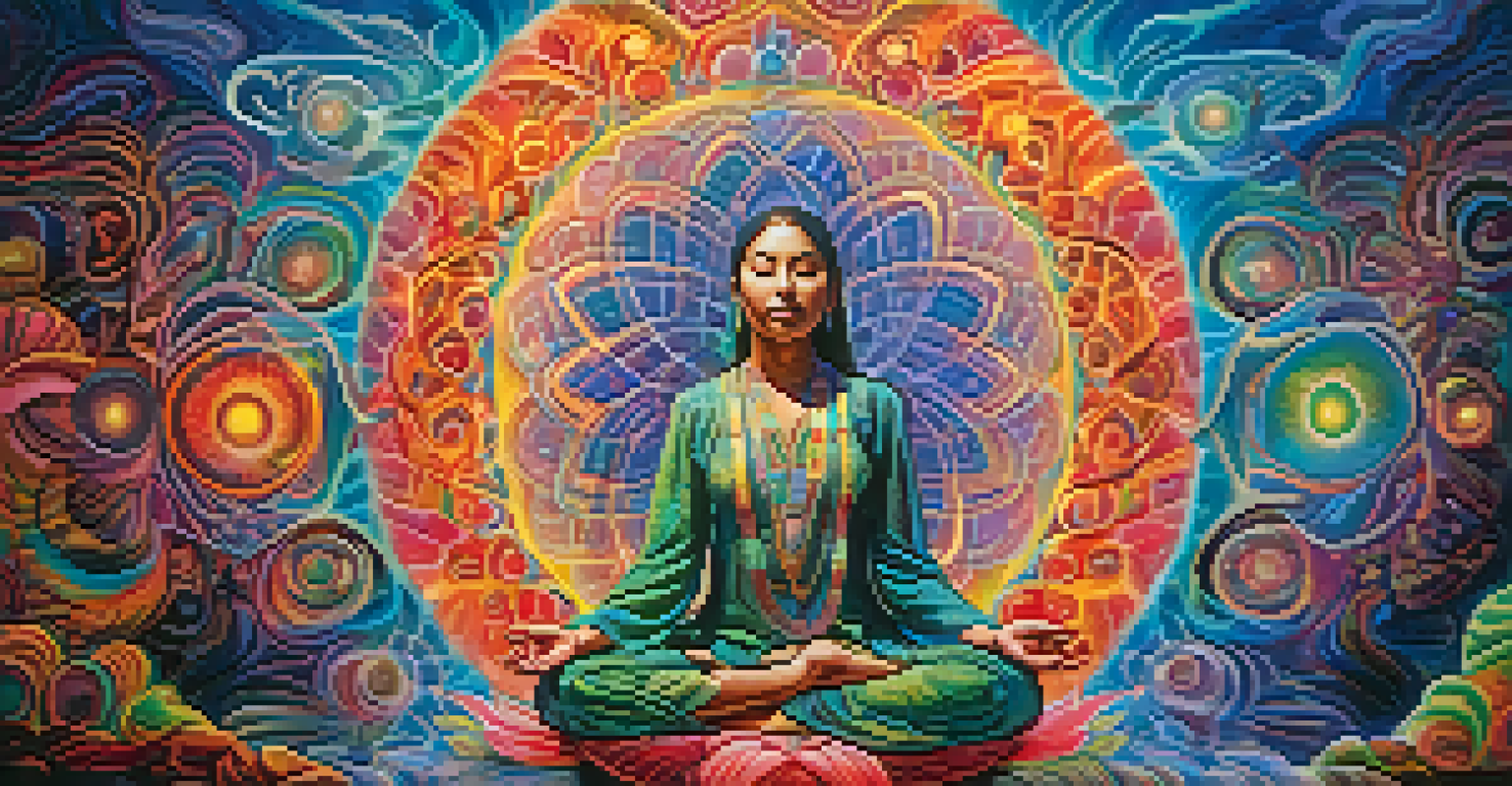The Symbolism of Ayahuasca in Contemporary Literature

Understanding Ayahuasca: A Brief Overview
Ayahuasca is a traditional Amazonian brew made from the Banisteriopsis caapi vine and other plants. Known for its psychoactive properties, it has been used for centuries in spiritual and healing ceremonies. In contemporary literature, Ayahuasca represents a profound journey into the self, offering insights into the human experience. It serves as a metaphor for exploration, transformation, and the quest for meaning in life.
The greatest journey is the journey inward.
As authors weave Ayahuasca into their narratives, they often highlight its dual nature: it can be both a tool for enlightenment and a source of chaos. This complexity deepens the symbolism, allowing readers to connect with their own journeys. By exploring Ayahuasca, writers tap into themes of spirituality, identity, and the interconnectedness of life, making it a potent symbol in modern storytelling.
Furthermore, the ritualistic aspect of Ayahuasca ceremonies adds layers to its representation. These ceremonies are often communal, emphasizing the importance of shared experience and connection. This communal aspect resonates with readers, showcasing how individual journeys can lead to collective understanding and healing.
Ayahuasca as a Catalyst for Transformation
In many contemporary literary works, Ayahuasca acts as a catalyst for personal transformation. Characters who engage with the brew often undergo profound changes, shedding old identities and embracing new perspectives. This transformation mirrors the struggles people face in their own lives, making the symbolism relatable and impactful.

For example, in various novels, protagonists confront their darkest fears and traumas during Ayahuasca experiences. These moments serve as a metaphor for facing inner demons, highlighting the necessity of vulnerability in the healing process. This connection to transformation resonates deeply with readers, inspiring them to reflect on their personal journeys.
Ayahuasca as a Transformation Tool
Ayahuasca serves as a powerful catalyst for personal transformation, allowing characters to confront their fears and embrace new perspectives.
Moreover, the transformative nature of Ayahuasca often leads to themes of rebirth and renewal. Just as the plants used in the brew grow in the dense Amazon rainforest, characters often find new life and purpose after their experiences. This cyclical idea of death and rebirth adds depth to the narrative and reinforces the symbolism of Ayahuasca as a powerful agent of change.
Cultural Significance of Ayahuasca in Literature
The cultural significance of Ayahuasca cannot be understated, especially in contemporary literature that seeks to bridge traditional wisdom with modern understanding. Many authors draw on the rich history of Ayahuasca within indigenous cultures, respecting its roots while exploring its broader implications. This cultural context adds authenticity and depth to the narratives.
We are all connected; to each other, to the earth, to the universe.
Writers often depict Ayahuasca as a means of reconnecting with ancient wisdom and spiritual practices. Characters may find themselves on a quest to understand their heritage or to rediscover lost traditions. This search for cultural identity resonates with readers, particularly in an increasingly globalized world where such connections are often diluted.
Additionally, the portrayal of Ayahuasca serves to raise awareness about indigenous rights and the importance of preserving traditional practices. As literature presents Ayahuasca in this light, it encourages readers to reflect on their own relationship with nature and spirituality, fostering a sense of responsibility toward cultural preservation.
Ayahuasca's Representation of the Inner Journey
Many contemporary authors use Ayahuasca as a metaphor for the inner journey of self-discovery. The brew's effects often lead characters to explore their subconscious minds, confronting unresolved issues and hidden truths. This exploration echoes the universal human experience of seeking understanding and clarity within oneself.
Through vivid descriptions of the Ayahuasca experience, writers create immersive narratives that invite readers to embark on their own introspective journeys. The symbolism of diving deep into consciousness resonates with those who have grappled with their identities, fears, and desires. This connection encourages empathy and understanding among readers.
Cultural Significance in Literature
The brew is depicted as a means to reconnect with ancient wisdom, highlighting the importance of cultural identity and preservation in modern narratives.
Furthermore, the inner journey represented by Ayahuasca often emphasizes the importance of introspection in personal growth. As characters navigate their experiences, they learn valuable lessons about acceptance, forgiveness, and love. This emphasis on self-awareness serves as a reminder that the journey inward is just as vital as any external adventure.
Ayahuasca and the Exploration of Consciousness
Ayahuasca's role in contemporary literature often extends to the exploration of consciousness itself. Many authors delve into the altered states of perception induced by the brew, questioning the nature of reality and existence. This theme resonates with readers who are curious about the boundaries of human understanding.
In various narratives, characters experience vivid visions and heightened awareness during their Ayahuasca journeys. These experiences challenge conventional perceptions of reality, inviting readers to consider alternative ways of knowing and experiencing the world. This exploration of consciousness encourages a broader dialogue about the mysteries of the human mind.
Additionally, the symbolism of Ayahuasca often intersects with discussions on mindfulness and presence. As characters learn to embrace the present moment through their experiences, readers are reminded of the importance of living consciously. This connection to mindfulness speaks to a growing desire for deeper understanding in our fast-paced, modern lives.
Interconnectedness and Unity in Ayahuasca Narratives
One of the most compelling themes in literature featuring Ayahuasca is the idea of interconnectedness. Characters who partake in Ayahuasca ceremonies often experience a profound sense of unity with nature, humanity, and the universe. This theme speaks to a universal longing for connection and belonging.
Through shared experiences during ceremonies, characters often come to realize that their individual struggles are part of a larger human experience. This revelation fosters empathy and understanding, allowing readers to reflect on their own connections to others. The symbolism of Ayahuasca thus serves as a bridge between individual and collective experiences.
Exploration of Consciousness Themes
Ayahuasca narratives often delve into altered states of perception, prompting discussions about the nature of reality and the importance of mindfulness.
Moreover, this sense of interconnectedness highlights the importance of community and support in personal healing. As characters bond with others during their Ayahuasca journeys, they illustrate the power of human connection in overcoming adversity. This theme encourages readers to seek and cherish their own communities, reinforcing the value of shared experiences.
The Future of Ayahuasca Symbolism in Literature
As contemporary literature continues to evolve, the symbolism of Ayahuasca is likely to grow and change. With increasing interest in spirituality and alternative healing practices, writers may explore new dimensions of Ayahuasca's significance. This evolution presents both opportunities and challenges for authors seeking to portray its complexities authentically.
Future narratives may delve deeper into the ethical considerations surrounding Ayahuasca, including issues of cultural appropriation and commercialization. As more people engage with the brew, it is crucial for authors to navigate these topics with sensitivity and respect. This awareness can enrich the symbolism, leading to more nuanced representations in literature.

Ultimately, the future of Ayahuasca symbolism in literature holds the potential for deeper connections and understanding. As readers continue to seek meaning in their own lives, the themes of transformation, interconnectedness, and consciousness will resonate. Through these narratives, Ayahuasca will likely remain a powerful symbol of the human experience.